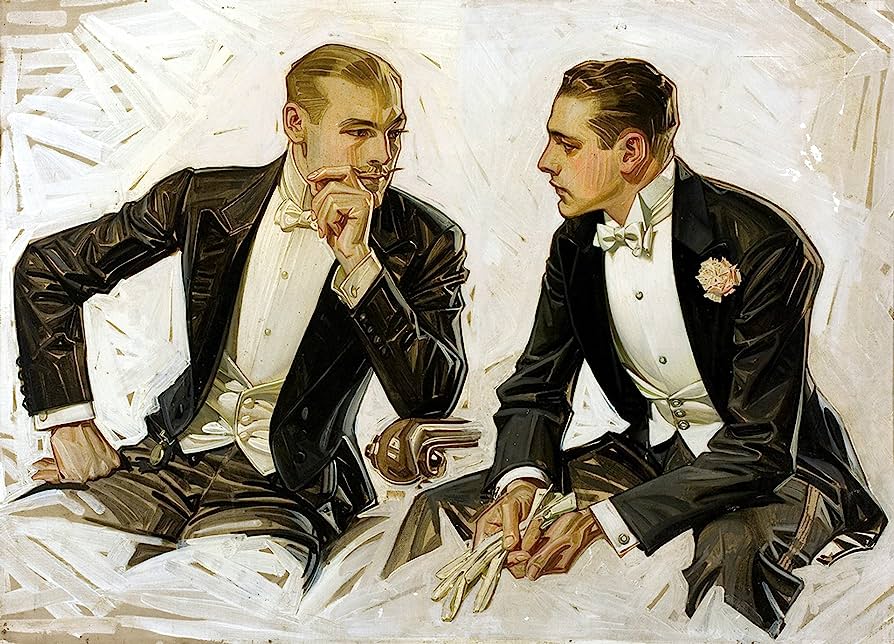
Eye For Elegance
By Christian Chensvold
Ralph Lauren Magazine, Fall 2008
Norman Rockwell’s name is synonymous with the golden age of American illustration, while that of J. C. Leyendecker, his friend and closest rival, barely sparks a light of recognition.
Now a new monograph—only the second ever—seeks to rescue Leyendecker’s reputation as a singular figure in American art. “J. C. Leyendecker,” written by Laurence S. Cutler and Judy Goffman Cutler of the National Museum of American Illustration in Newport, Rhode Island, was drawn from an archive of more than 1,300 images by the largely forgotten illustrator. “People come into the museum and mistake Leyendeckers for Rockwells,” says Laurence Cutler, “but it’s actually the other way around: Rockwell took techniques and ideas for magazine covers from Leyendecker, yet it’s Rockwell who’s the cultural hero.”
For all their similarities, there are also key differences between the two artists. Rockwell’s genius lay in his acute depictions of the simple life, while Leyendecker’s revealed itself through gentility and glamour—a high-tone Madison Avenue to Rockwell’s folksy Main Street. And Leyendecker not only chronicled the fashions of his day but, through his work as an advertising illustrator, helped to define them.
Born in 1874, Joseph Christian Leyendecker emigrated with his family from Germany to Chicago in 1882. After winning a magazine-sponsored art contest (beating out Maxfield Parrish), he returned to Europe to study in Paris under the Art Nouveau master Alphonse Mucha before ultimately settling in the New York City suburb of New Rochelle. Between about 1900 and 1940, Leyendecker drew 322 covers for The Saturday Evening Post, illustrating every facet of American life. He also created memorable ad campaigns for Pierce-Arrow automobiles, Interwoven Socks, and Kuppenheimer clothing. In the process, he developed a signature style based on careful draftsmanship, a flowing brushstroke, and an eye for elegance. His favored subjects were the privileged few—Harvard rowers, belles of the ball, perfect couples—with an emphasis on style over substance.
In 1905, Leyendecker created his most memorable legacy, leaping from the purely visual to the powerfully symbolic. In an age when detachable shirt collars were de rigeur, Leyendecker’s Arrow Collar Man—a mascot for the menswear company Cluett, Peabody & Co.—became what Cutler calls the first real advertising campaign and produced the first sex symbol of either gender.
In a campaign lasting twenty-five years, Leyendecker portrayed an archetypal American masculinity that was equal parts football hero and urbane man-about-town. Whether clutching a briar pipe or guiding a winsome debutante across the dance floor, the Arrow Collar Man embodied a vision of American manhood that was both rugged and refined—every woman’s dream. “At one point,” says Cutler, “Leyendecker’s Arrow Collar Man got more fan mail than Rudolph Valentino.”
But all was not as it seemed beneath the polished surfaces of Leyendecker’s images. The impossibly handsome model for much of his work—the chiseled-chin Adonis that made men green with envy and women red with lust—was Charles Beach, Leyendecker’s lifelong romantic partner. “The essence of Leyendecker’s images is that they’re masculine but elegant,” says Cutler, “and I think it has a tremendous amount to do with his love for Charles.”
As the ’20s roared, Leyendecker emerged as America’s foremost celebrity illustrator. In a clandestine speakeasy run by chorus-girl-turned-society-hostess Texas Guinan, he and Charles rubbed elbows with such luminaries as John Jacob Astor, Gloria Swanson, Al Jolson, Clara Bow, John Barrymore, Dorothy Parker, and Mae West. Surrounded by a throng of flappers and playboys, Leyendecker took note of their style and mannerisms and used them for his art.
Amid the smoke and laughter of the Jazz Age, Leyendecker met another literary luminary: F. Scott Fitzgerald, who likely attributed some of the artist’s predilections—such as remaining mysteriously aloof at the lavish galas he threw—to the doomed hero Jay Gatsby. “The characters of F. Scott Fitzgerald’s The Great Gatsby come to mind in many Leyendecker pictures of the twenties,” writes Michael Schau in his 1974 book about the artist (the only other major Leyendecker study): “Well-to-do, civilized people with self-confidence reinforced by breeding, education, position, and taste.”
By 1940, however, the champagne bottle of the Jazz Age had been emptied, and Leyendecker’s world of glamour and gaiety had been subsumed by wartime anxiety. When Leyendecker died in 1951, Charles Beach held a yard sale where sketches by the artist sold for 50 cents. Most of the buyers were fellow illustrators who revered a master the public had already forgotten.
Today art collectors have come to appreciate Leyendecker’s particular genius. Good pencil studies start at about $5,000, while large and coveted canvases can fetch nearly $2 million.
The seven people who attended Leyendecker’s wake included Charles, a few relatives, a priest, and a funeral director. Only one other person came to bid farewell: Norman Rockwell, who would continue to chronicle an increasingly changing American society until his own death in 1978, when Leyendecker’s paintings seemed merely quaint reminders of a charming but vanished elegance.


I don’t know if it is noted elsewhere on this site, but I just left the dentist’s office where Leyendecker is featured in a recent issue (sorry, but I was in no state to note/memorize details)of the Saturday Evening Post. A great, brief overview of his career with a bunch of examples of his work for the Post. He obviously had a prolific and varied career. I’m considering browsing the second hand book stores in Boston/Cambridge area looking for old magazines with his covers and (horrors, I know!!!) pulling off the covers and framing them for the spare room where I dress and keep my books and a couple of armories of clothes.
Thanks for this posting. Love the site. Jack
It is great art, indeed.